Abstract
OBJECTIVE--To determine the efficacy of oral nimodipine in reducing cerebral infarction and poor outcomes (death and severe disability) after subarachnoid haemorrhage. DESIGN--Double blind, placebo controlled, randomised trial with three months of follow up and intention to treat analysis. To have an 80% chance with a significance level of 0.05 of detecting a 50% reduction in an incidence of cerebral infarction of 15% a minimum of 540 patients was required. SETTING--Four regional neurosurgical units in the United Kingdom. PATIENTS--In all 554 patients were recruited between June 1985 and September 1987 out of a population of 1115 patients admitted with subarachnoid haemorrhage proved by the results of lumbar puncture or computed tomography, or both. The main exclusion criterion was admission to the neurosurgical units more than 96 hours after subarachnoid haemorrhage. There were four breaks of code and no exclusions after entry. One patient was withdrawn and in 130 treatment was discontinued early. All patients were followed up for three months and were included in the analysis, except the patient who had been withdrawn. INTERVENTIONS--Placebo or nimodipine 60 mg was given orally every four hours for 21 days to 276 and 278 patients, respectively. Treatment was started within 96 hours after subarachnoid haemorrhage. END POINTS--Incidence of cerebral infarction and ischaemic neurological deficits and outcome three months after entry. MEASUREMENTS--Demographic and clinical data, including age, sex, history of hypertension and subarachnoid haemorrhage, severity of haemorrhage according to an adaptation of the Glasgow coma scale, number and site of aneurysms on angiography, and initial findings on computed tomography were measured at entry. Deterioration, defined as development of a focal sign or fall of more than one point on the Glasgow coma scale for more than six hours, was investigated by using clinical criteria and by computed tomography, by lumbar puncture, or at necropsy when appropriate. All episodes of deterioration and all patients with a three month outcome other than a good recovery were assessed by a review committee. MAIN RESULTS--Demographic and clinical data at entry were similar in the two groups. In patients given nimodipine the incidence of cerebral infarction was 22% (61/278) compared with 33% (92/276) in those given placebo, a significant reduction of 34% (95% confidence interval 13 to 50%). Poor outcomes were also significantly reduced by 40% (95% confidence interval 20 to 55%) with nimodipine (20% (55/278) in patients given nimodipine v 33% (91/278) in those given placebo). CONCLUSIONS--Oral nimodipine 60 mg four hourly is well tolerated and reduces cerebral infarction snd improves outcome after subarachnoid haemorrhage.
Full text
PDF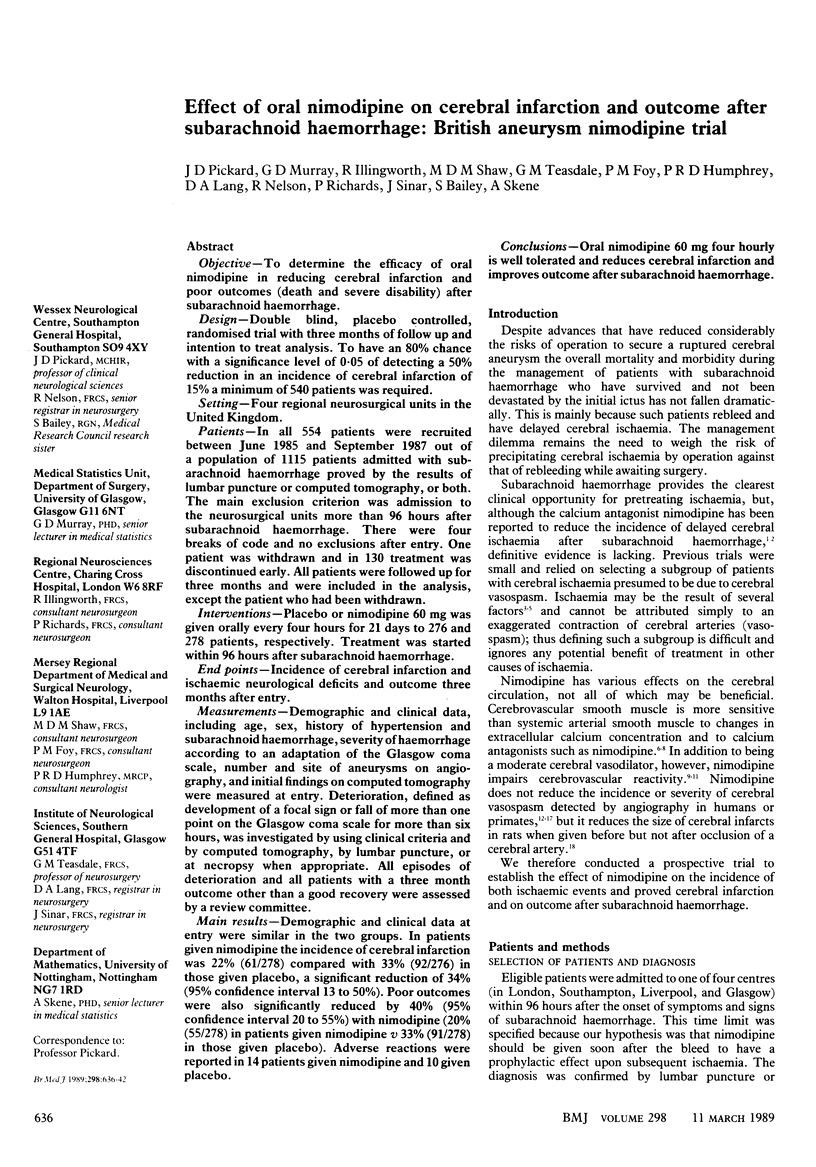
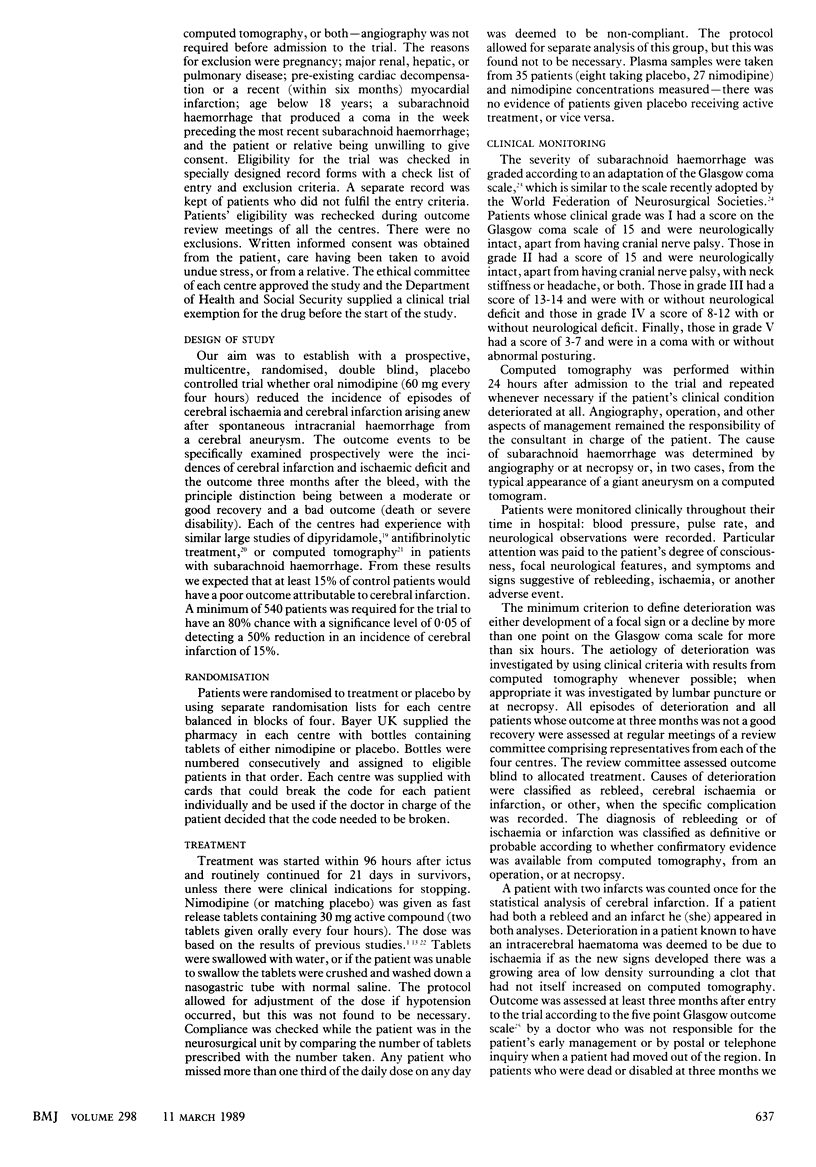
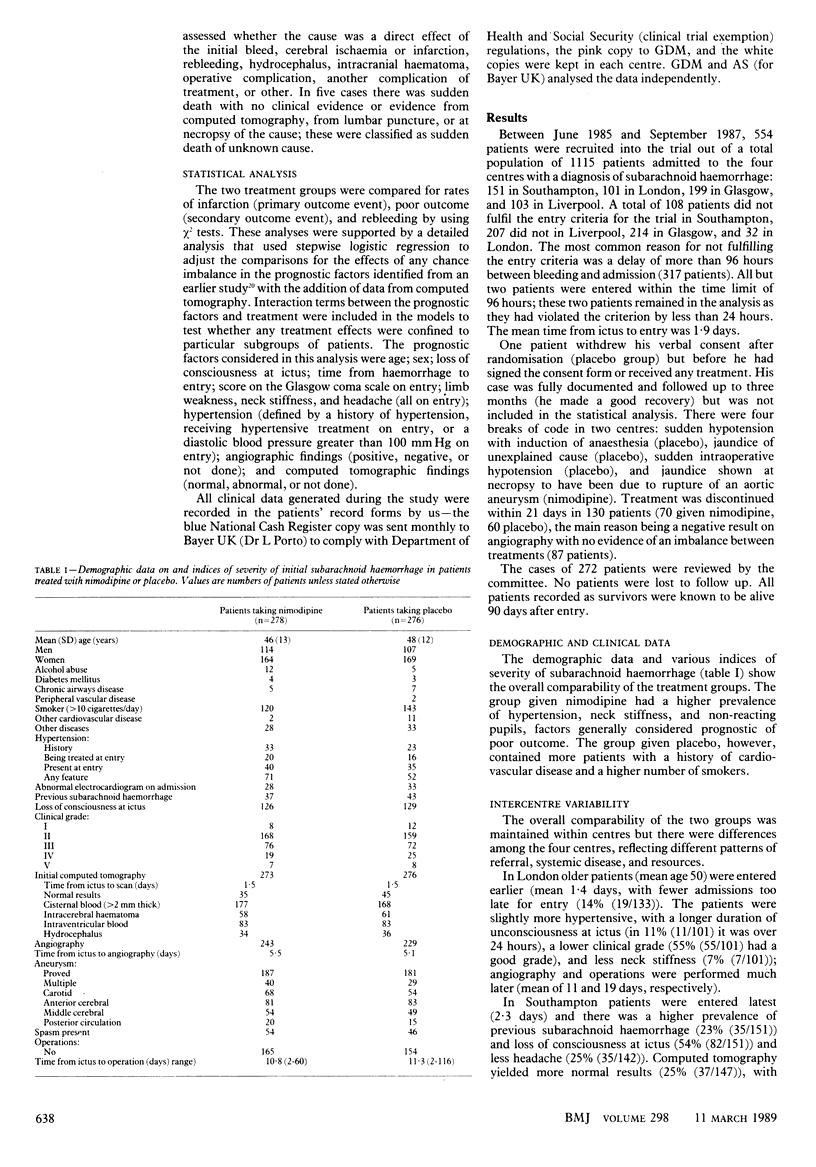
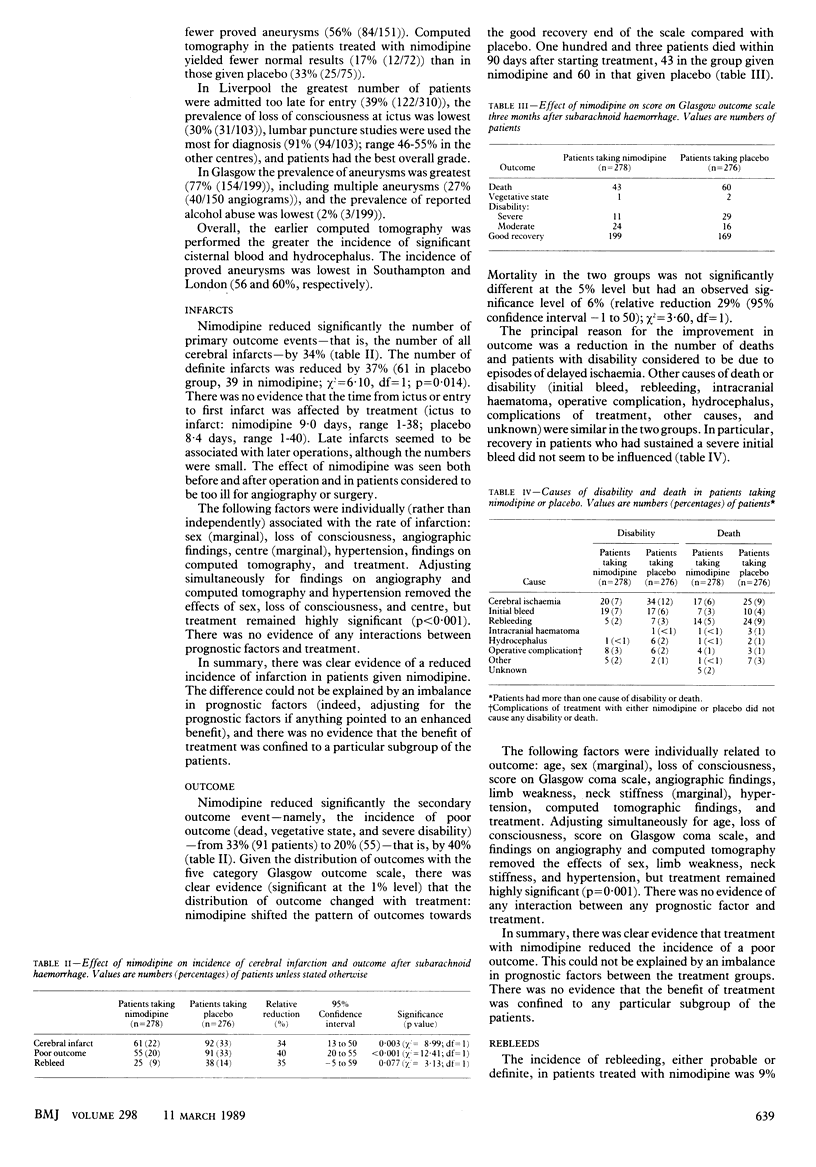
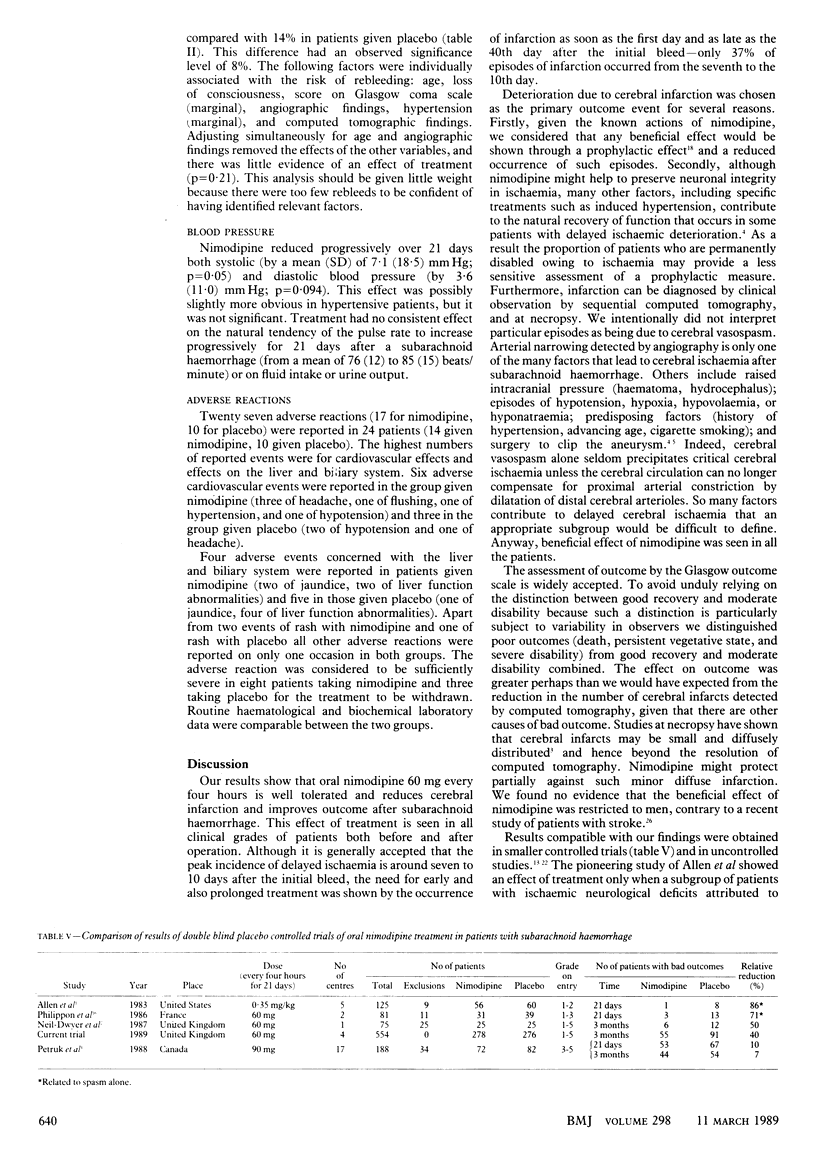
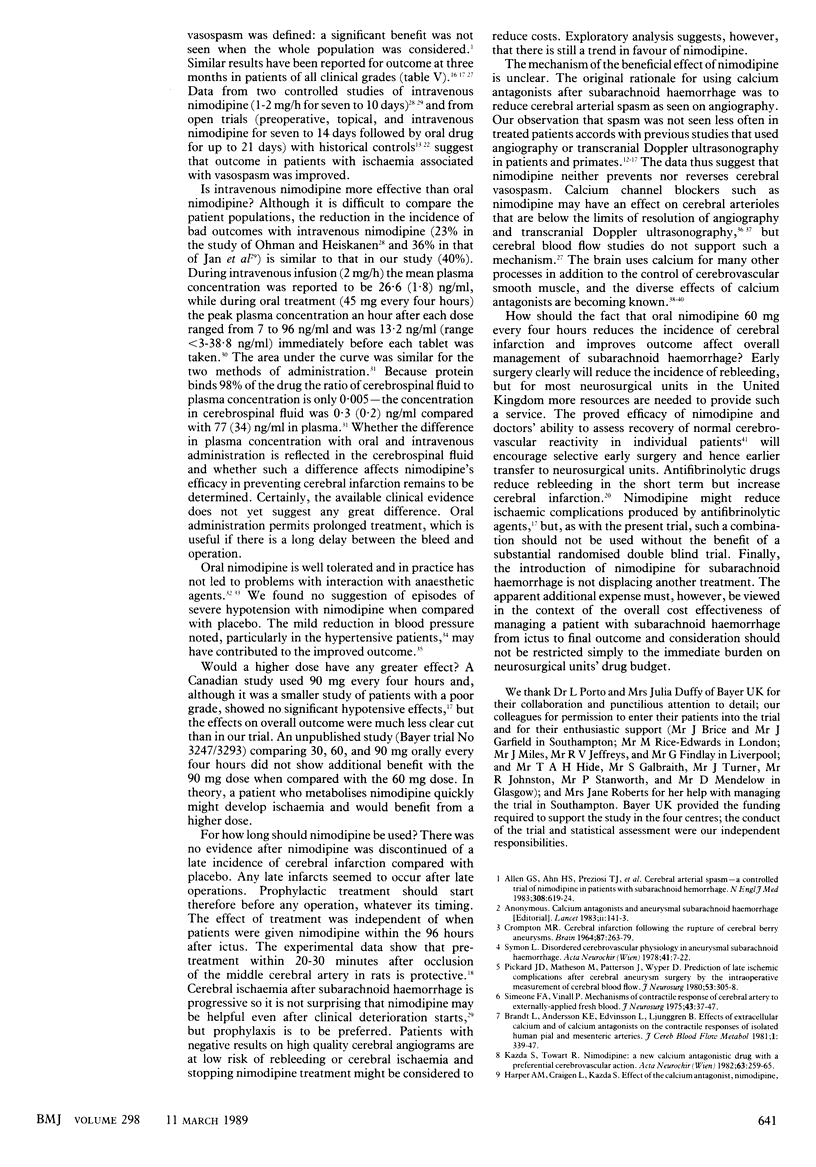

Selected References
These references are in PubMed. This may not be the complete list of references from this article.
- Allen G. S., Ahn H. S., Preziosi T. J., Battye R., Boone S. C., Boone S. C., Chou S. N., Kelly D. L., Weir B. K., Crabbe R. A. Cerebral arterial spasm--a controlled trial of nimodipine in patients with subarachnoid hemorrhage. N Engl J Med. 1983 Mar 17;308(11):619–624. doi: 10.1056/NEJM198303173081103. [DOI] [PubMed] [Google Scholar]
- Auer L. M. Acute operation and preventive nimodipine improve outcome in patients with ruptured cerebral aneurysms. Neurosurgery. 1984 Jul;15(1):57–66. doi: 10.1227/00006123-198407000-00011. [DOI] [PubMed] [Google Scholar]
- Brandt L., Andersson K. E., Edvinsson L., Ljunggren B. Effects of extracellular calcium and of calcium antagonists on the contractile responses of isolated human pial and mesenteric arteries. J Cereb Blood Flow Metab. 1981;1(3):339–347. doi: 10.1038/jcbfm.1981.37. [DOI] [PubMed] [Google Scholar]
- Brandt L., Ljunggren B., Andersson K. E., Edvinsson L., MacKenzie E., Tamura A., Teasdale G. Effects of topical application of a calcium antagonist (nifedipine) on feline cortical pial microvasculature under normal conditions and in focal ischemia. J Cereb Blood Flow Metab. 1983 Mar;3(1):44–50. doi: 10.1038/jcbfm.1983.5. [DOI] [PubMed] [Google Scholar]
- Gelmers H. J., Gorter K., de Weerdt C. J., Wiezer H. J. A controlled trial of nimodipine in acute ischemic stroke. N Engl J Med. 1988 Jan 28;318(4):203–207. doi: 10.1056/NEJM198801283180402. [DOI] [PubMed] [Google Scholar]
- Gotoh O., Mohamed A. A., McCulloch J., Graham D. I., Harper A. M., Teasdale G. M. Nimodipine and the haemodynamic and histopathological consequences of middle cerebral artery occlusion in the rat. J Cereb Blood Flow Metab. 1986 Jun;6(3):321–331. doi: 10.1038/jcbfm.1986.55. [DOI] [PubMed] [Google Scholar]
- Grotenhuis J. A., Bettag W., Fiebach B. J., Dabir K. Intracarotid slow bolus injection of nimodipine during angiography for treatment of cerebral vasospasm after SAH. A preliminary report. J Neurosurg. 1984 Aug;61(2):231–240. doi: 10.3171/jns.1984.61.2.0231. [DOI] [PubMed] [Google Scholar]
- Harris R. J., Branston N. M., Symon L., Bayhan M., Watson A. The effects of a calcium antagonist, nimodipine, upon physiological responses of the cerebral vasculature and its possible influence upon focal cerebral ischaemia. Stroke. 1982 Nov-Dec;13(6):759–766. doi: 10.1161/01.str.13.6.759. [DOI] [PubMed] [Google Scholar]
- Jan M., Buchheit F., Tremoulet M. Therapeutic trial of intravenous nimodipine in patients with established cerebral vasospasm after rupture of intracranial aneurysms. Neurosurgery. 1988 Aug;23(2):154–157. doi: 10.1227/00006123-198808000-00004. [DOI] [PubMed] [Google Scholar]
- Jennett B., Bond M. Assessment of outcome after severe brain damage. Lancet. 1975 Mar 1;1(7905):480–484. doi: 10.1016/s0140-6736(75)92830-5. [DOI] [PubMed] [Google Scholar]
- Kazda S., Towart R. Nimodipine: a new calcium antagonistic drug with a preferential cerebrovascular action. Acta Neurochir (Wien) 1982;63(1-4):259–265. doi: 10.1007/BF01728880. [DOI] [PubMed] [Google Scholar]
- Ljunggren B., Brandt L., Säveland H., Nilsson P. E., Cronqvist S., Andersson K. E., Vinge E. Outcome in 60 consecutive patients treated with early aneurysm operation and intravenous nimodipine. J Neurosurg. 1984 Nov;61(5):864–873. doi: 10.3171/jns.1984.61.5.0864. [DOI] [PubMed] [Google Scholar]
- Merin R. G. Calcium channel blocking drugs and anesthetics: is the drug interaction beneficial or detrimental? Anesthesiology. 1987 Feb;66(2):111–113. [PubMed] [Google Scholar]
- Middlemiss D. N., Spedding M. A functional correlate for the dihydropyridine binding site in rat brain. Nature. 1985 Mar 7;314(6006):94–96. doi: 10.1038/314094a0. [DOI] [PubMed] [Google Scholar]
- Mohsen F., Pomonis S., Illingworth R. Prediction of delayed cerebral ischaemia after subarachnoid haemorrhage by computed tomography. J Neurol Neurosurg Psychiatry. 1984 Nov;47(11):1197–1202. doi: 10.1136/jnnp.47.11.1197. [DOI] [PMC free article] [PubMed] [Google Scholar]
- Neil-Dwyer G., Mee E., Dorrance D., Lowe D. Early intervention with nimodipine in subarachnoid haemorrhage. Eur Heart J. 1987 Nov;8 (Suppl K):41–47. doi: 10.1093/eurheartj/8.suppl_k.41. [DOI] [PubMed] [Google Scholar]
- Nosko M., Weir B., Krueger C., Cook D., Norris S., Overton T., Boisvert D. Nimodipine and chronic vasospasm in monkeys: Part 1. Clinical and radiological findings. Neurosurgery. 1985 Feb;16(2):129–136. doi: 10.1227/00006123-198502000-00001. [DOI] [PubMed] [Google Scholar]
- O'Neill P., West C. R., Chadwick D. W., Conway M., Foy P. M., Maloney P., Pickard J. D., Spillane J. A., Shaw M. D. Post-ictal blood pressure in aneurysmal subarachnoid haemorrhage. Br J Neurosurg. 1988;2(2):153–159. doi: 10.3109/02688698808992664. [DOI] [PubMed] [Google Scholar]
- Ohman J., Heiskanen O. Effect of nimodipine on the outcome of patients after aneurysmal subarachnoid hemorrhage and surgery. J Neurosurg. 1988 Nov;69(5):683–686. doi: 10.3171/jns.1988.69.5.0683. [DOI] [PubMed] [Google Scholar]
- Petruk K. C., West M., Mohr G., Weir B. K., Benoit B. G., Gentili F., Disney L. B., Khan M. I., Grace M., Holness R. O. Nimodipine treatment in poor-grade aneurysm patients. Results of a multicenter double-blind placebo-controlled trial. J Neurosurg. 1988 Apr;68(4):505–517. doi: 10.3171/jns.1988.68.4.0505. [DOI] [PubMed] [Google Scholar]
- Philippon J., Grob R., Dagreou F., Guggiari M., Rivierez M., Viars P. Prevention of vasospasm in subarachnoid haemorrhage. A controlled study with nimodipine. Acta Neurochir (Wien) 1986;82(3-4):110–114. doi: 10.1007/BF01456369. [DOI] [PubMed] [Google Scholar]
- Phillis J. W., O'Regan M. H., Walter G. A. Effects of nifedipine and felodipine on adenosine and inosine release from the hypoxemic rat cerebral cortex. J Cereb Blood Flow Metab. 1988 Apr;8(2):179–185. doi: 10.1038/jcbfm.1988.47. [DOI] [PubMed] [Google Scholar]
- Pickard J. D., Matheson M., Patterson J., Wyper D. Prediction of late ischemic complications after cerebral aneurysm surgery by the intraoperative measurement of cerebral blood flow. J Neurosurg. 1980 Sep;53(3):305–308. doi: 10.3171/jns.1980.53.3.0305. [DOI] [PubMed] [Google Scholar]
- Pickard J. D., Walker V., Vile J., Perry S., Smythe P. J., Hunt R. Oral nimodipine reduces prostaglandin and thromboxane production by arteries chronically exposed to a periarterial haematoma and the antifibrinolytic agent tranexamic acid. J Neurol Neurosurg Psychiatry. 1987 Jun;50(6):727–731. doi: 10.1136/jnnp.50.6.727. [DOI] [PMC free article] [PubMed] [Google Scholar]
- Shaw M. D., Foy P. M., Conway M., Pickard J. D., Maloney P., Spillane J. A., Chadwick D. W. Dipyridamole and postoperative ischemic deficits in aneurysmal subarachnoid hemorrhage. J Neurosurg. 1985 Nov;63(5):699–703. doi: 10.3171/jns.1985.63.5.0699. [DOI] [PubMed] [Google Scholar]
- Simeone F. A., Vinall P. Mechanisms of contractile response of cerebral artery to externally-applied fresh blood. J Neurosurg. 1975 Jul;43(1):37–47. doi: 10.3171/jns.1975.43.1.0037. [DOI] [PubMed] [Google Scholar]
- Stullken E. H., Jr, Balestrieri F. J., Prough D. S., McWhorter J. M. The hemodynamic effects of nimodipine in patients anesthetized for cerebral aneurysm clipping. Anesthesiology. 1985 Mar;62(3):346–348. doi: 10.1097/00000542-198503000-00023. [DOI] [PubMed] [Google Scholar]
- Symon L. Disordered cerebro-vascular physiology in aneurysmal subarachnoid haemorrhage. Acta Neurochir (Wien) 1978;41(1-3):7–22. doi: 10.1007/BF01809133. [DOI] [PubMed] [Google Scholar]
- Takayasu M., Bassett J. E., Dacey R. G., Jr Effects of calcium antagonists on intracerebral penetrating arterioles in rats. J Neurosurg. 1988 Jul;69(1):104–109. doi: 10.3171/jns.1988.69.1.0104. [DOI] [PubMed] [Google Scholar]
- Teasdale G. M., Drake C. G., Hunt W., Kassell N., Sano K., Pertuiset B., De Villiers J. C. A universal subarachnoid hemorrhage scale: report of a committee of the World Federation of Neurosurgical Societies. J Neurol Neurosurg Psychiatry. 1988 Nov;51(11):1457–1457. doi: 10.1136/jnnp.51.11.1457. [DOI] [PMC free article] [PubMed] [Google Scholar]
- Tettenborn D., Dycka J., Volberg E., Düdden P. Blood pressure and heart rate during treatment with nimodipine in patients with subarachnoid hemorrhage. Neurochirurgia (Stuttg) 1985 May;28 (Suppl 1):84–86. doi: 10.1055/s-2008-1054109. [DOI] [PubMed] [Google Scholar]
- Vermeulen M., Lindsay K. W., Murray G. D., Cheah F., Hijdra A., Muizelaar J. P., Schannong M., Teasdale G. M., van Crevel H., van Gijn J. Antifibrinolytic treatment in subarachnoid hemorrhage. N Engl J Med. 1984 Aug 16;311(7):432–437. doi: 10.1056/NEJM198408163110703. [DOI] [PubMed] [Google Scholar]
- Vinge E., Andersson K. E., Brandt L., Ljunggren B., Nilsson L. G., Rosendal-Helgesen S. Pharmacokinetics of nimodipine in patients with aneurysmal subarachnoid haemorrhage. Eur J Clin Pharmacol. 1986;30(4):421–425. doi: 10.1007/BF00607954. [DOI] [PubMed] [Google Scholar]


